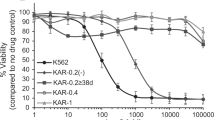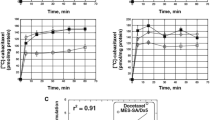Abstract.
Purpose: The aim of this study was to investigate the multidrug resistance (MDR) pattern, MDR gene and P-glycoprotein (P-gp) expression, and P-gp function in drug-induced human T-lymphoblastoid leukemia MOLT-4 sublines. Methods: The MDR sublines were developed by exposing the parental MOLT-4 cells to stepwise increasing concentrations of anticancer drugs daunorubicin (DNR), vinblastine (VBL) and doxorubicin (DOX). Degrees of resistance were assessed in terms of IC50 values in an MTT assay and the P-gp function was evaluated in terms of rhodamine 123 (Rh123) accumulation and efflux. The percentage of cells undergoing apoptosis was determined by flow cytometry after staining with annexin V-FITC and propidium iodide. The levels of P-gp and MDR mRNA expression were estimated using the PE-conjugated anti-P-gp monoclonal antibody 17F9 and quantitative real-time reverse transcription-polymerase chain reaction. Results: Three MOLT-4 sublines were established and revealed a 2- to 115-fold resistance to the anticancer reagents DNR, VBL and DOX as compared to the parental cell line. The highest MDR was expressed in MOLT-4/DNR cells, which was overcome by the P-gp modulator, cyclosporin A (CsA). The resistant sublines showed a decreased accumulation and an increased efflux of Rh123 in proportion to the degree of resistance, and these were completely reversed in the presence of 8 µM CsA. The decreased apoptotic response in these cell lines was clearly associated with the degree of drug resistance. P-gp antigen and MDR1 mRNA were highly expressed in both the MOLT-4/DNR and MOLT-4/DOX sublines. Less-resistant MOLT-4/VBL cells expressed lower levels of MDR1 mRNA and P-gp, even though the cell line was established by exposing the parental MOLT-4 cells to VBL for longer (5 months) than to the other two reagents (3 months). Conclusions: MOLT-4 cells were able to acquire a high level of drug resistance by culturing the cells in the presence of certain anticancer drugs, and acquisition of the resistance was relatively reagent-specific. The degrees of resistance to the anticancer drugs were well correlated with the expressions of MDR1 mRNA and functional P-gp, and were also associated with a decreased response to apoptosis.
Similar content being viewed by others
Author information
Authors and Affiliations
Additional information
Electronic Publication
Rights and permissions
About this article
Cite this article
Liu, ZL., Onda, K., Tanaka, S. et al. Induction of multidrug resistance in MOLT-4 cells by anticancer agents is closely related to increased expression of functional P-glycoprotein and MDR1 mRNA. Cancer Chemother Pharmacol 49, 391–397 (2002). https://doi.org/10.1007/s00280-001-0411-5
Received:
Accepted:
Issue Date:
DOI: https://doi.org/10.1007/s00280-001-0411-5




